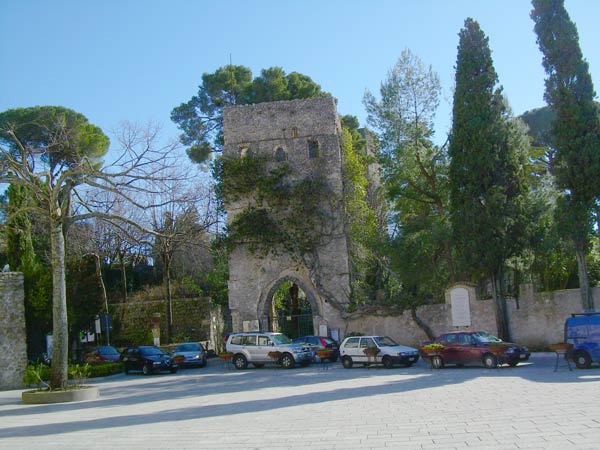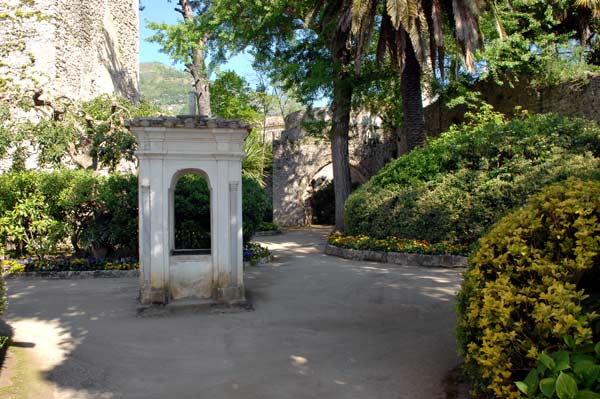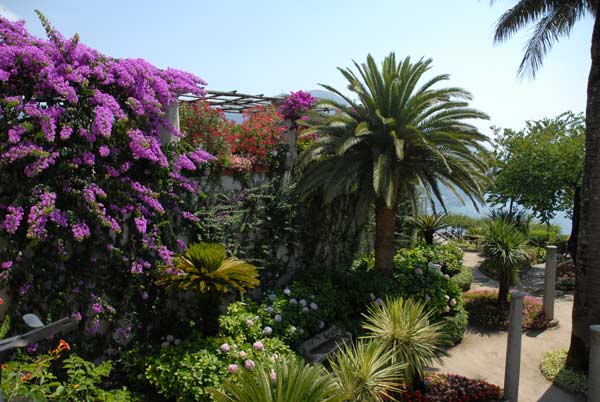
Villa Rufolo
This post is also available in:
 English (Inglese)
English (Inglese)
ENGLISH TRANSATION BELOW
Villa Rufolo è un edificio del centro storico di Ravello (SA), il cui impianto iniziale risale al secolo XIII, con ampi rimaneggiamenti ottocenteschi. Erosa dal tempo e dall’incuria, Â stata in parte restaurata grazie al prezioso intervento dell’industriale scozzese Francis Neville Reid, esperto di botanica e d’arte antica, che ne fu proprietario tra il XIX e il XX secolo. Al modello originario, sintesi perfetta e unica di architettura araba, sicula e normanna, si sono sovrapposti rimaneggiamenti sette e ottocenteschi, fra cui l’aggiunta del chiostro (XVIII secolo) e dei giardini romantici. Si accede alla Villa grazie ad un’apertura ogivale nella “Torre d’ingresso” e dopo un breve viale si giunge ad uno slargo dominato dalla “Torre Maggiore”, affacciata sui terrazzamenti a strapiombo della Costiera amalfitana e del Golfo di Salerno, ricchi di giardini quasi sempre in fiore.
I GIARDINI
Un viale alberato ottocentesco conduce al giardino di Villa Rufolo, conosciuto anche con il nome di Giardino dell’Anima. Risalente al XIII secolo, con tracce d’epoca medievale, il giardino si sviluppa su due livelli, che devono la veste attuale a Reid. Oltre a introdurvi numerose specie esotiche, vi costruì l’impianto di irrigazione. Per risolvere il problema dell’acqua, Reid stabilì una convenzione con la Giunta Municipale del Comune di Ravello e fece costruire a sue spese un acquedotto che portava acqua dalla contrada del Tabernacolo fino alla piazza Vescovado di Ravello, dove alimenta tutt’ora una fontana d’uso pubblico. Reid si impegnò alla perpetua manutenzione di entrambi.
La cura dei giardini fu affidata a Luigi Cicalese. Le specie allora presenti erano moltissime sia autoctone che esotiche, con una consistente presenza di rose, in particolare la rosa ‘Dijon’, molte delle quali sono quasi ora del tutto scomparse.
Nel tempo, il giardino ha subito molti danni, in particolare nel Novenceto: dalla confisca durante la guerra per opera degli inglesi, all’avvento di vari fenomeni naturali, come il nubifragio che si abbattè nel 1951 sul litorale, fino alla costruzione della strada provinciale nel 1955 che distrusse la parte superiore del giardino.
Tra la vasta flora qui presente vi sono numerose piante di pelargoni coltivati sia in vaso sia nelle aiuole, in particolare vicino alla Cappella, dove servono per ornarne le vicinanze.
I GIARDINI OGGI
Il giardini si affacciano ad Oriente sul panorama, attraverso il Belvedere. Lungo il lato settentrionale, si incontrano i resti della Balnea, area in antichità destinata alle cure termali e solo di recente riemersa grazie agli ultimi scavi archeologici. Ai piedi della scaletta che immette nel giardini inferiore, si trovano il Bagno turco, al cui interno sono ben visibili i resti delle canalizzazioni dell’acqua e la volta a cupola perfettamente integra. In fondo al percorso che attraversa i giardini si raggiungono gli edifici inferiori della residenza e il Chiostro moresco.
Tra le numerose specie botaniche presenti, vi sono il pino domestico (Pinus pinea), il cipresso comune (Cupressus sempervirens), il tiglio nostrano (Tilia platyphyllos) e le ortensie.
RICHARD WAGNER
Nel maggio del 1880, il celebre compositore Richard Wagner (1813-1883), in visita a Ravello, rimase colpito dal giardino di Villa Rufolo e vi si ispirò per la scenografia del Parsifal; immaginò infatti la torre medievale sprofondare nel nulla e diventare un giardino incantato, le piante tropicali assumere le sembianze di splendide fanciulle, e infine il giardino stesso trasformarsi in un deserto nell’attimo in cui Parsifal uccide il negromante Klingsor.
ENGLISH VERSION, by courtesy of Umberto Mucci, www.wearetheitalians.com
 WTI Magazine #79 2016 May 13
WTI Magazine #79 2016 May 13
Author : Italian Botanical Heritage Translation by:
Villa Rufolo is a building in the historic center of Ravello (SA), whose original structure dates back to the thirteenth century, with large nineteenth-century alterations. Eroded by time and neglect, it was partially restored thanks to the valuable assistance of the enterpreneur Scot Francis Neville Reid, expert in botany and ancient art, who owned it in the nineteenth and twentieth centuries.
The original model, perfect and unique synthesis of Arabic, Sicilian and Norman style, was altered by seven-nineteenth-century modifications, including the addition of the cloister (XVIII century) and of romantic gardens. You enter the villa through an arched opening in the “Entrance tower” and after a short avenue you come to a clearing dominated by “Major Tower”, which points out on the terraces overlooking the Amalfi Coast and the Gulf of Salerno, with rich gardens almost always in bloom.
THE GARDENS
A nineteenth-century tree-lined avenue leads to the garden of Villa Rufolo, also known as the Garden of the Soul. Dating back to the thirteenth century, with traces of the Middle Ages, the garden is on two levels, which owe to Reid their current design. As well as introducing a number of exotic species, Reid built the irrigation system. To solve the water problem, he settled an agreement with the City Council of the City of Ravello and built at his own expense an aqueduct that carried water from the district of the Tabernacle to the Bishopric square of Ravello, where it still feeds a public fountain. Reid pledged to perpetual maintenance of both.
The care of the gardens was then entrusted to Louis Cicalese. The species then present were many native and exotic, with a substantial presence of roses, especially the “Dijon” rose, many of which are now almost completely disappeared.
 Over time, the garden suffered damages, especially in ‘900: from the confiscation by the British during the war to various natural phenomena, like the storm that struck in 1951 on the coast, up to the construction of the road in 1955 that destroyed the top of the garden.
Over time, the garden suffered damages, especially in ‘900: from the confiscation by the British during the war to various natural phenomena, like the storm that struck in 1951 on the coast, up to the construction of the road in 1955 that destroyed the top of the garden.
THE GARDENS TODAY
The gardens overlook East on the landscape, through the Belvedere. Along the northern side, there are the remains of Balnea, an area in antiquity destined to spa treatments and only recently re-emerged thanks to the latest archaeological excavations. At the foot of the ladder that leads to the lower gardens, there is the turkish bath, where there are clearly visible remains of water pipes and the intact domed ceiling. Down the route through the gardens you reach the buildings of the lower house and the Moorish cloister.
Among the many plant species found there are the stone pine (Pinus pinea), the common cypress (Cupressus sempervirens), the large-leaved lime (Tilia platyphyllos), and hydrangeas.
RICHARD WAGNER
In May 1880, the famous composer Richard Wagner (1813-1883), visiting Ravello, was impressed by the garden of Villa Rufolo and inspired by it for the scenery of Parsifal; he imagined the medieval tower sink into nowhere to become an enchanted garden, the tropical plants to take the form of beautiful girls, and finally the whole garden to turn into a desert in the moment in which Parsifal kills the sorcerer Klingsor.
This post is also available in:
 English (Inglese)
English (Inglese)
Contatti
Piazza Duomo - Ravello(SA)
089 857621
info@villarufolo.it
Altre info
Intero euro 5.00; ridotto euro 3.00 (bambini 0-12; adulti over 65 ); gruppi euro 4.00 (superiore a 15 persone)
Tutti i giorni
Dalle 9:00 alle 17:00 con ultimo ingresso alle ore 16:45








